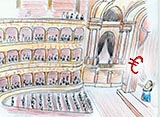
I like that tune
Follow the Music
Music beguiles smart. Smart begets smart. Smart will make you richer. That, in a nutshell, is the finding of a new CESifo paper that brings a fresh note to the cadences of economic success.
As CESifo researchers Oliver Falck and Stephan Heblich, and their colleagues Michael Fritsch and Anne Otto, point out, being around smart people makes us smarter and more productive. The obvious conclusion for a policymaker is that it certainly pays to attract smart people: it will raise a location's overall "smartness" ratio and productivity levels. So, how do you attract such magic-touch individuals?
Two strategies seem to work: either offer subsidies or tax breaks, or provide amenities that will improve the quality of life and thus make the city more attractive. Or both.
The paper concentrates on the second of these strategies. It analyses how differences in the local supply of cultural amenities affect the share of high-skilled workers, and examines whether high-skilled workers generate productive spillovers that benefit other individuals in the same local labour market. To assess these productive spillovers, the authors used a 36-year panel of individual-level wage data from the German social insurance records, which allowed them to distinguish among low, medium- and high-skilled workers in 325 West German districts.
Given that they wanted to find out the effect exerted by high-skilled workers who are attracted by cultural amenities, they needed to find externally caused variations in the geographic distribution of amenities that cause the share of high-skilled workers to vary among regions. Otherwise, it could well be that the supply of cultural amenities follows high-skilled workers, spurred by their willingness and ability to pay for such amenities.
To tackle this, the authors drew on a quasi-natural experiment in German history that relates the geographic distribution of baroque opera houses to past rulers' competition for prestigious cultural amenities. In the era following the Thirty Years' War, many rulers spent oodles of money on prestigious buildings, extravagant parties, or unusual hobbies. Some chose to build opera houses, thus sowing the seed for a concentration of cultural life. What makes opera so useful for the purpose of this paper is that opera performances are a particularly complex type of artistic activity, requiring not just musicians, singers and sometimes a ballet, but also stage and costume designers, make-up artists and poets and composers. Furthermore, artists attract pubs and other cultural activities, such as music clubs and independent small theatres, that thrive on the fringes of well-established mainstream institutions.
This can be easily discerned today: baroque opera house locations host significantly more artists than other comparable locations, a sort of unintended consequence of a baroque ruler's idiosyncratic preferences.
The study's results suggest that high-skilled workers are attracted by cultural amenities and that all skill groups in a location benefit from the agglomeration of high-skilled workers: a one-percentage point increase in the share of high-skilled workers causes low-skilled workers' wages to increase by 1.4 percent; skilled workers' wages increase by 1.6 percent, and high-skilled workers enjoy 1.1-percent higher wages. You can feel the effect of the opera house in your wallet.
There is more. The proximity to cultural amenities, measured as the distance to the next baroque opera house, has become increasingly important over the 36-year observation period. In the past, physical capital and infrastructure were probably the best predictors for a location's economic success. With the shift from manufacturing goods to the more knowledge-intensive production of innovation, the factors that increase a location's quality of life and that help to attract innovative people have become pivotal.
The authors are confident that they have identified a causal relationship between cultural amenities and the location choice of high-skilled workers. Given the well-documented spillover effects of the concentration of such workers, the policy question arises (and not for the first time) whether cultural amenities like theatres and opera houses should be considered public goods that need to be financed with taxpayers' money.
Still, the authors urge caution. If the overall supply of high-skilled workers is constant, this would imply a beggar-thy-neighbour policy: one region's gain would be another region's loss. Be it as it may, investing in cultural amenities does pay off. Even if you don't like opera.
Oliver Falck, Michael Fritsch, Stephan Heblich and Anne Otto: "Music in the Air: Estimating the Social Return to Cultural Amenities", CESifo Working Paper No. 5183
Other CESifo Working Papers by Oliver Falck
Other CESifo Working Papers by Stephan Heblich
